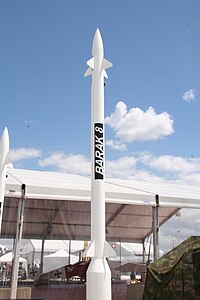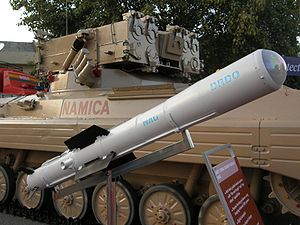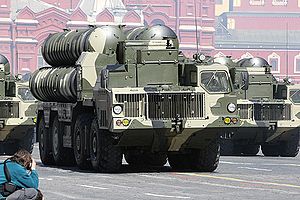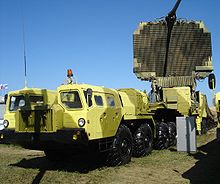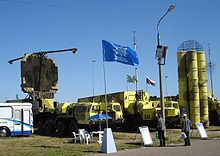Surface To Air/Air Defence
Akash
Akash (
Sanskrit: आकाश
Ākāś "Sky") is
India's medium range
surface-to-air missile defense system developed by the
Defence Research and Development
(
DRDO) and
Bharat Electronics Limited(BEL) as part of the
Integrated Guided Missile Development Program. The missile can target aircraft up to 30 km away, at altitudes up to 18,000 m. Akash can be fired from both tracked and wheeled platforms.is said to be capable of both conventional and nuclear warheads, with a reported payload of 60 kg. A nuclear warhead could potentially give the missile the capability to destroy both aircraft and warheads from ballistic missiles. The missile battery is described as being able to track and attack several targets simultaneously.
| Akash |
|---|

An Akash missile being test fired from the Integrated Test Range (ITR), Chandipur, Orissa. |
| Type | Surface-to-air missile |
|---|
| Place of origin |  India India |
|---|
| Production history |
|---|
| Designer | DRDO |
|---|
| Manufacturer | Bharat Electronics Limited, Bharat Dynamics Limited |
|---|
| Produced | 2009 |
|---|
| Number built | IAF: 1000 missiles, IA: 1000 missiles |
|---|
| Specifications (Akash missile) |
|---|
| Weight | 720 kg |
|---|
| Length | 5.78 m |
|---|
Diameter
| 35 cm |
|---|
|
| Warhead | Digital proximity fuse is coupled with a 55 kg pre-fragmented warhead |
|---|
| Warhead weight | 55 kg |
|---|
Detonation
mechanism
Number of threats Destroyed
Area Covered
| RF Proximity
16
2000km sq
|
|---|
|
| Propellant | Integrated Ramjet Rocket Engine. |
|---|
Operational
range | 25-30km |
|---|
| Flight altitude | 18 km |
|---|
| Speed | Mach 2.5
|
|---|
Organisation
An Akash battery comprises four 3D phased array radars and four launchers with three missiles each, all of which are interlinked. Each radar is able to track 16 targets simultaneously and control a launcher with 3 missiles. Hence it is reported to be able to track 64 targets and simultaneously attack any 12 of those targets at one time. The Akash system is comparable to the Patriot system, but unlike the Patriot, Akash is fully mobile and capable of protecting a moving convoy of vehicles. Like the Patriot, the Akash is really an air defence SAM which has been tested in a ballistic missile role. The system provides air defence missile coverage of 2,000 km².
The India military's combined orders of the Akash, including radar systems(WLR and Surveillance), have a total worth of $5.2 billion (

23,300 crore)
Development and history
The first test flight of Akash missile was conducted in 1990, with development flights up to March 1997.
Two Akash missiles intercepted two fast moving targets in simultaneous engagement mode in 2005. 3-D
Central Acquisition Radar (3D-CAR) group mode performance is also fully established.
Along with India, a limited number of other countries including the US, Russia, Japan, Israel, and some EU countries have developed operational multitarget-handling surface-to-air missile systems. With the successful user trials of Akash, India has validated the technology and operational efficacy of this missile system. This system is claimed to be more accurate than the
MIM-104 Patriot as it has thrust during the entire course of its flight compared to the Patriot that has thrust only for the first 12 seconds, after which the missile coasts, thus making it less accurate. Apart from that the Akash can be launched from static or mobile platforms, including a battle tank. \The Akash Missile Development cost of

1,000crore ($200 million), including the project sanction of

600 crore ($120 million), is 8-10 times lower than the cost of similar system developments in so called advanced countries. Akash, which is considered as Indian ‘poor man’s Patriot,’ has certain unique characteristics like mobility, all-the-way-powered flight till target interception, multiple target handling, digitally-coded command guidance and fully automatic operation.”.
Akash Mk-2
Development work for Akash Mk-2 variant has begun, since recently Ministry of Defence officially granted funds and permission for its further development.DRDO is confident to field and test new Akash Mk-2 within 3 year period, major changes that Akash MK-2 will have is the range of missile, Army and Air force wants Akash MK-2 to have range of 40 to 60 km from its current range (Akash MK-1) of just 25 km. for that DRDO has been working on using better composite booster with lengthened booster section to achieve the desired range .Akash MK-1 is guided by phased array fire control radar called Rajendra BSR (Battery Surveillance Radar) which is PESA radar, while Akash Mk-2 will have a Rajendra derivative AESA radar to perform the same role, AESA radar will give it better tracking, and engagement functions. Work on AESA variant has begun and almost nearing completion
Description
Akash is a surface-to-air missile with an
intercept range of 30 km. It has a launch weight of 720 kg, a diameter of 35 cm and a length of 5.78 metres. Akash flies at supersonic speed, reaching around
Mach 2.5. It can reach an altitude of 18 km and can be fired from both tracked and wheeled platforms. An on-board guidance system coupled with an actuator system makes the missile maneuverable up to 15g loads and a tail chase capability for end game engagement. A digital proximity fuse is coupled with a 55 kg pre-fragmented warhead, while the safety arming and detonation mechanism enables a controlled detonation sequence. A self-destruct device is also integrated. It is propelled by an Integrated Ramjet Rocket Engine. The use of a
ramjet propulsion system enables sustained speeds without deceleration throughout its flight. The Missile has command guidance in its entire flight.
The design of the missile is somewhat similar to that of the
SA-6 with four long tube ramjet inlet ducts mounted mid-body between wings. For pitch/yaw control four clipped triangular moving wings are mounted on the mid-body. For roll control four inline clipped delta fins with ailerons are mounted before the tail. However, the internal schema shows a different layout with an onboard digital computer, no Semi-active seeker, different propellant, different actuators and command guidance datalinks. The Akash carries an onboard radio-proximity fuse.
System
Each Akash battery consists of four self-propelled Launchers (3 Akash SAMs each), a Battery Level Radar - the Rajendra, and a Command post (Battery Control Centre). Two batteries are deployed as a Squadron (Air Force), while up to four form an Akash Group (Army configuration). In both configurations, an extra Group Control Centre (GCC) is added, which acts as the Command and Control HQ of the Squadron or Group. Based on a single mobile platform, GCC establishes links with Battery Control Centres and conducts air defense operations in coordination with air defense set up in a zone of operations.
For early warning, the GCC relies on the
Central Acquisition Radar. However, individual batteries can also be deployed with the cheaper, 2-D BSR (Battery Surveillance Radar) with a range of over 100 km.
Each Akash battery can engage up to four targets. Each battery has four launchers with three missiles each, with each Rajendra able to guide four missiles in total, with a maximum of two missiles per target. Up to a maximum of four targets can be engaged by a typical battery with a single Rajendra if one missile is allotted per target.
Communications between the various vehicles are a combination of wireless and wired links. The entire system is designed to be set up quickly and to be highly mobile for high survivability.
The Akash system can be deployed by rail, road or air.
